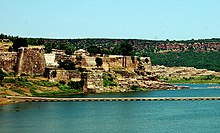| Battle of Gagron | |||||||||
|---|---|---|---|---|---|---|---|---|---|
| Part of Mewar-Malwa Conflict | |||||||||
 Fort of Gagron in Rajasthan | |||||||||
| |||||||||
| Belligerents | |||||||||
|
Vassal states: |
Malwa Sultanate Gujarat Sultanate | ||||||||
| Commanders and leaders | |||||||||
|
Rana Sanga Ajja Jhala Rao Viramdeva Prithiviraj Kachwaha Medini Rai Haridas kesaria |
Mahmud Khilji II (POW) Asaf Khan | ||||||||
The Battle of Gagron was fought in 1519 between Mahmud Khalji II of Malwa and Kingdom of Mewar Rana Sanga. The conflict took place in Gagron (in the present-day Indian state of Rajasthan) and resulted in Sanga's victory, with him taking Mahmud captive and annexing significant territory.
Background
Following the death of the Sultan of Malwa, Nasir-ud-Din Khalji, a succession struggle erupted amongst his sons. Mahmud Khalji II emerged victorious, primarily with the aid of the Rajput chief Medini Rai. The latter amassed considerable influence, resulting in the enmity of the Muslim nobles, with even the new sultan finding it necessary to appeal to Muzaffar Shah II of Gujarat. A Gujarati army was dispatched to Mandu, held by Medini Rai's son, and besieged it. The Rajput chief in turn appealed to Rana Sanga of Mewar for aid, who then marched his army into Malwa, reaching Sarangpur. However, Mandu was captured by the Gujaratis, prompting Sanga to return to Mewar alongside Medini Rai, who was then employed in his service.
Battle
In retribution for them entering his territory, Mahmud marshalled an army against the Mewaris and marched it through Gagron. Sanga advanced with a large army from Chittor reinforced by the Rathors of Merta under Rao Viramdeva, and met Mahmud, accompanied by the Gujarat auxiliaries under Asaf Khan. The Mewari cavalry made a charge through that of the Gujarati, with the surviving men scattering. They subsequently did the same to the Malwa army, resulting in a decisive victory. Mahmud was wounded and taken prisoner by Rana Sanga, with most of his officers having died and his army decimated. Asaf Khan's son was killed, though he himself managed to escape.
Aftermath
Sanga subsequently took control of Bhilsa, Raisen, Sarangpur, Chanderi and Ranthambore. Mahmud was kept captive at Chittor for 6 months, though the Rana himself is said to have personally tended to his wounds. He was subsequently allowed an "honourable" return to his own lands, though one of his sons remained at Mewar as a hostage. Mahmud later sent Sanga a jewelled belt and crown as gifts. Sanga presented the Chittor fortress to Haridas Kesaria after their victory, who humbly declined and accepted a jagir of 12 villages in return.
References
- Chandra, Satish (2004). Medieval India: From Sultanat to the Mughals-Delhi Sultanat (1206-1526) - Part One. Har-Anand Publications. p. 224. ISBN 8124110646.
- Rima Hooja (2006). A History of Rajasthan. Rupa and Company. pp. Page no- 450. ISBN 978-81-291-0890-6.
- ^ Sandhu, Gurcharn Singh (2003). A Military History of Medieval India. Vision Books. p. 386. ISBN 9788170945253.
- ^ Sarda, Bilas. Maharana Sanga: The Hindupat, the Last Great Leader of the Rajput Race. 1918. Reprint. London: Forgotten Books, 2013. 70-3. Print.
- Hooja, Rima (2006). A History of Rajasthan. Rupa & Company. p. 450. ISBN 978-81-291-0890-6.
- Singh, Mahendra Pratap (2001). Shivaji, Bhakha Sources and Nationalism. Books India International.
Rana publicly announced that he would give away his whole kingdom of Mewar to Charan Haridas of the Mahiyaria clan. Haridas humbly refused the offer and accepted only twelve villages . One of those villages was still kept in the possession of Charan's descendants , when Kavi Raja Shyamaldan wrote his book in the closing decades of the 19th century.
External links
 Media related to Battle of Gagron at Wikimedia Commons
Media related to Battle of Gagron at Wikimedia Commons